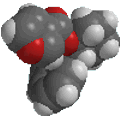Principal Functional group |
- The principal
functional group is used to define the class the compound belongs
to e.g. an alcohol, ROH
- The principal functional group is
the highest priority functional group. Functional group priority is discussed later.
- The principal functional group is usually given
the lowest locant possible.
- The priority order applies to the functional groups.
- When a group is named as a substituent, the priority order does not apply.
|
| Longest chain |
- The longest
continuous chain containing the principal
functional group defines the root
name.
- Other groups attached
to this chain are called substituents.
- If there are two
chains of equal length, then the choice that gives the simplest substituents
is chosen.
|
Numbering
(i.e. assigning locants) |
- The numbers that define the positions of the principal
functional group and substituents are called locants.
- Compounds are numbered from one end of the longest
continuous chain.
- The locants are assigned
such that the principal functional group gets the lowest possible locant.
- If this results in a "tie" then the first point of difference
rule is applied so that
the first time a difference in numbering occurs, then the method that
gives the lower number at this first difference is used.
- In the event that
there is no first point of difference then alphabetisation
is used.
- Note that a locant can only be omitted if they are a. "1" and b. would be unambiguous (see later).
|

